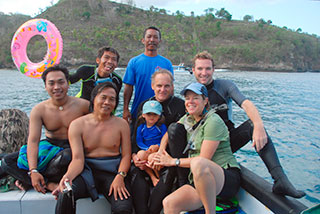
(Back row L to R):Divemaster :Moyo (I Made Sudirata), Captain
Wayan Yapta. (Middle row L to R):I Made Dharma
Jaya (from CI) Brett with a lovely young lady (Miss Marina
Hobson), and Manager of Bali
Diving Academy Lembongan Sven
Fautz. (Front row L to R):Iwan Dewantama (CI), Tierney Thys.
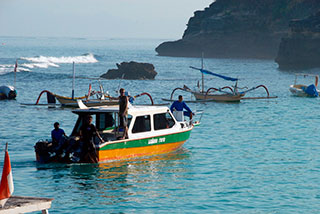
Tagging boat
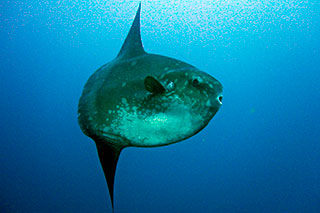
Indonesian mola
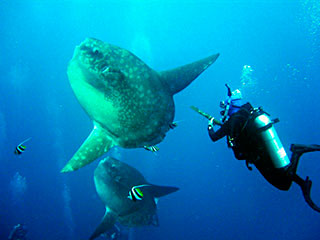
Brett approaches sunfish...
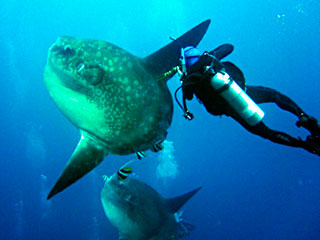
and inserts tag.
|
This October, the mola team
headed East--far East. We enthusiastically accepted an invitation
from marine conservationist Dr. Mark Erdmann to join Conservation
InternationaI, Indonesia and the Indonesian Institute of
Sciences (LIPI) in conducting a Rapid Biological Assessment
(RAP)* for the Nusa Penida area. This region is a beautiful
three island archipelago off the southeast corner of Bali.
We were solicited to join this particular RAP team since
ocean sunfish are a star attraction in these waters and between
July and October comprise a large part of the tourist draw--perhaps
too large.
Anecdotal evidence suggests that increasing
hordes of overly enthusiastic SCUBA divers are perturbing
the giant ocean sunfishes in Bali--causing them to alter
their behavior and avoid their traditional cleaning stations.
Cleaning stations are where large pelagic fish like sunfish,
sharks, groupers and the like, assume non-threatening poses
and solicit the parasite-preening services of smaller fishes
like butterfly fish, angel fish and wrasses. (For more information
on this behavior see: Adult
Emperor angelfish (Pomacanthus imperator ) clean Giant sunfishes
(Mola mola) at Nusa Lembongan, Indonesia, Coral Reefs (2006)
25: 208) 
Ocean sunfish support an impressive load
of parasites--some 50 species from 40 different genera have
been reported to occur in and/or on the thick-skinned bodies
of the molas (Molidae
Parasites  ).
So partaking of regular piscine spa treatments is of vital
importance to the wellbeing of these fishes. Bali, and particularly
the waters around the islands of Nusa Lembogan and Nusa Penida,
provide just the right combination of ocean conditions to
create the ultimate sunfish resort spa. We're hoping our
work can help keep it that way. ).
So partaking of regular piscine spa treatments is of vital
importance to the wellbeing of these fishes. Bali, and particularly
the waters around the islands of Nusa Lembogan and Nusa Penida,
provide just the right combination of ocean conditions to
create the ultimate sunfish resort spa. We're hoping our
work can help keep it that way.
Our research here has several aims: to document
and protect the preferred habitats of mola; to educate the
public about this valuable marine asset and; to engage in
discussions with commercial dive operators and government
officials regarding how best to protect this resource by
instituting a voluntary code
of conduct  for
all dive guides and diving tourists. We are working closely
with Michael Cortenbach and his team from Bali
Diving Academy. Our research is also working to establish
a marine protected area here along with the tireless efforts
of Conservation International Indonesia's staff including
Mark Erdmann, Ketut Putra, Iwan Dewantama, Laure Katz and
more. for
all dive guides and diving tourists. We are working closely
with Michael Cortenbach and his team from Bali
Diving Academy. Our research is also working to establish
a marine protected area here along with the tireless efforts
of Conservation International Indonesia's staff including
Mark Erdmann, Ketut Putra, Iwan Dewantama, Laure Katz and
more.
The last time we visited these waters was
in 2004 when, after much searching, we placed two pop-off
archival satellite tags on molas. We only received back a
small amount of data from those tags however. (See Indonesia
2004 Expedition) So this time, we refined our tag attachment
technique and with our tags programmed to release in 6 months
on April 15th 2009 we hope for a much more comprehensive
look into the lives of Indonesian molas. We also had a much
easier time finding animals to tag this time around! In fact
on Oct 9th two hours before low tide, we tagged an animal
on our very first dive.
|
Within 8 minutes
of entering the water at Blue Corner--a popular dive spot
off Nusa Lembogan--Brett Hobson deployed the tag. The 1 m
TL sunfish was being cleaned at 25-30m depth in 22 C water,
below the 26 C surface waters. Brett inserted tag #08A0768
89297 into the animal's right side behind and below the dorsal
fin. Then on October 11th, 4 dives later, Brett tagged our
second mola (1 m TL) at Crystal Bay off Nusa Penida at 20
meters in 26 C water. This animal was also being cleaned,
relaxing in the calm waters one hour after high tide. Brett
inserted tag #08A0782 89298 on the left side of the animal.
While we await the tags release date in
April next year, we have asked all divers here to keep an
eye out for these tagged animals and send their sightings
to Iwan Dewantama i.dewantama@conservation.org.
Click here for the request poster.
|
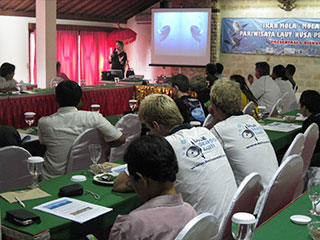
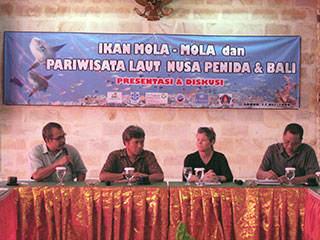
(L to R) Made Suarnatha, Ketut S. Putra, Tierney Thys, Yos
Amerta |
With our tagging completed
we returned to the mainland and on October 17th, team leader,
Dr. Tierney Thys delivered an informational keynote lecture
to a large group of commercial dive operators and Balinese
government officials. This meeting was organized by Conservation
International Indonesia. In Bali alone, there are more than
100 commercial dive operators and at least 30 different outfits
that just service the Nusa Penida area alone. The informational
meeting proved very encouraging and all parties seemed amenable
to working together to conserve the unique marine treasures
of Nusa Penida.
Also during this trip Dr. Thys was invited
to give two lectures at the innovative new Green School of
Bali located up in Ubud--one hour inland from the coast.
This inspired preK through 8th grade school is built entirely
from sustainable bamboo and teaches an integrated green curriculum.
It is the brainchild of longtime Bali residents and visionaries,
John and Cynthia Hardy. To see a snippet of the talk click
here. For more on the Green School visit www.greenschool.org.
|

